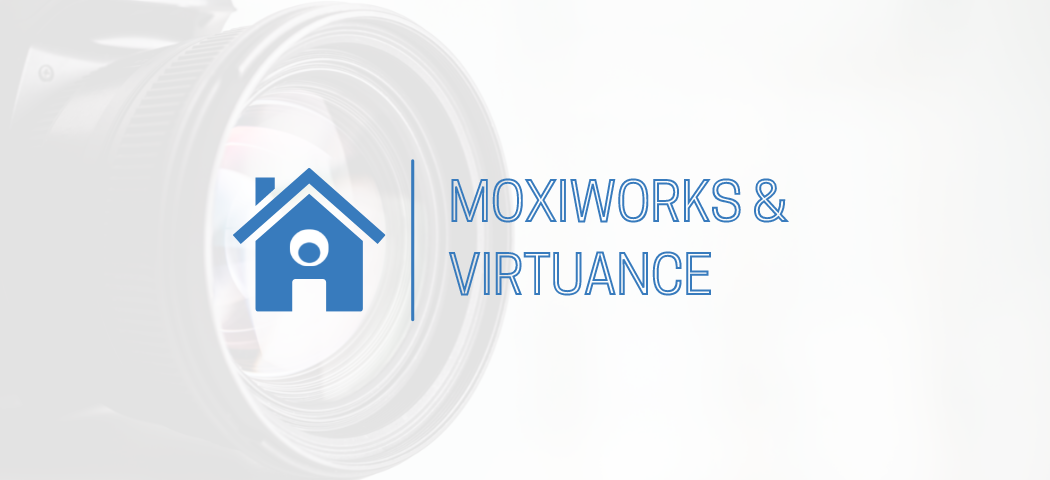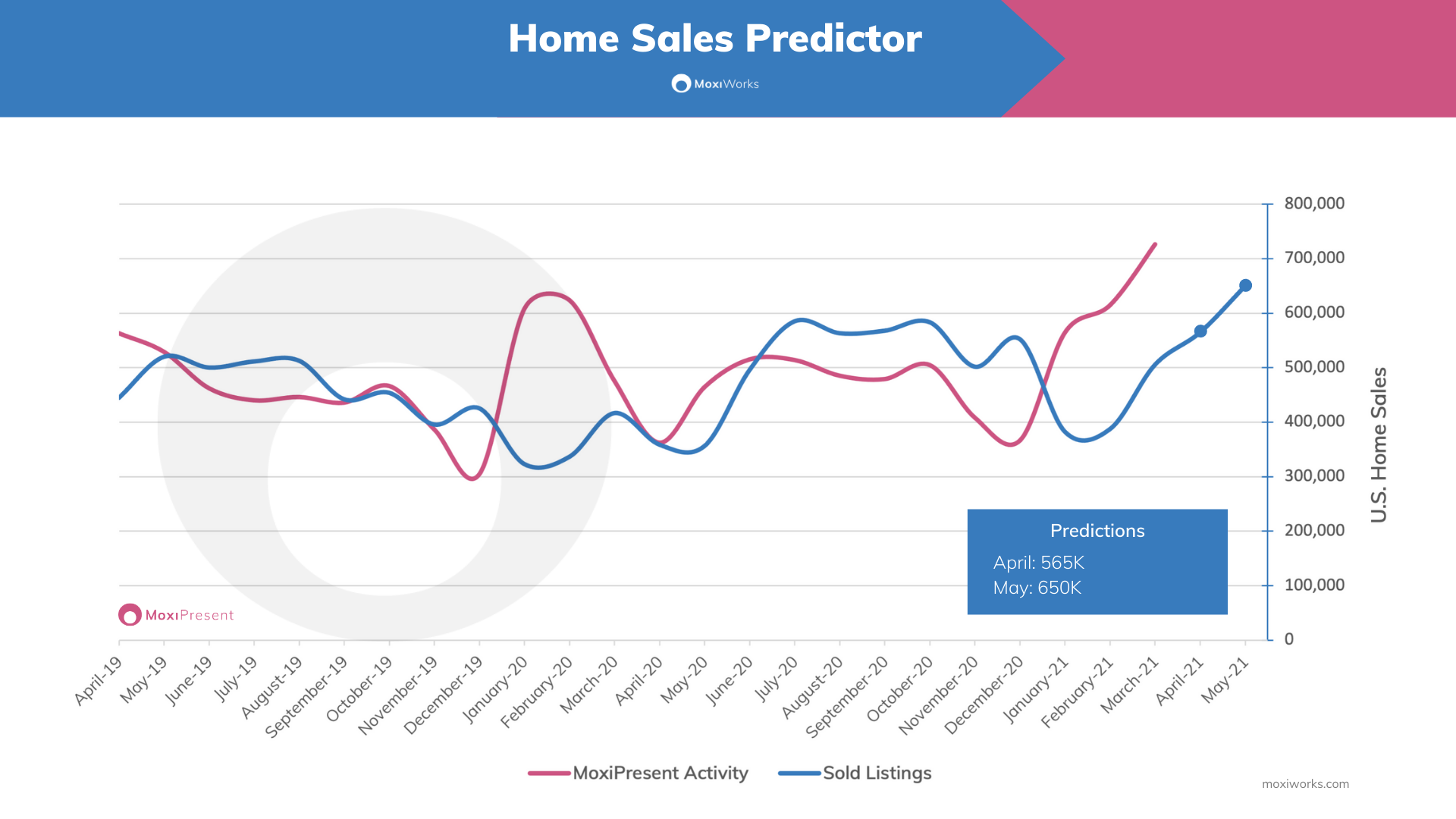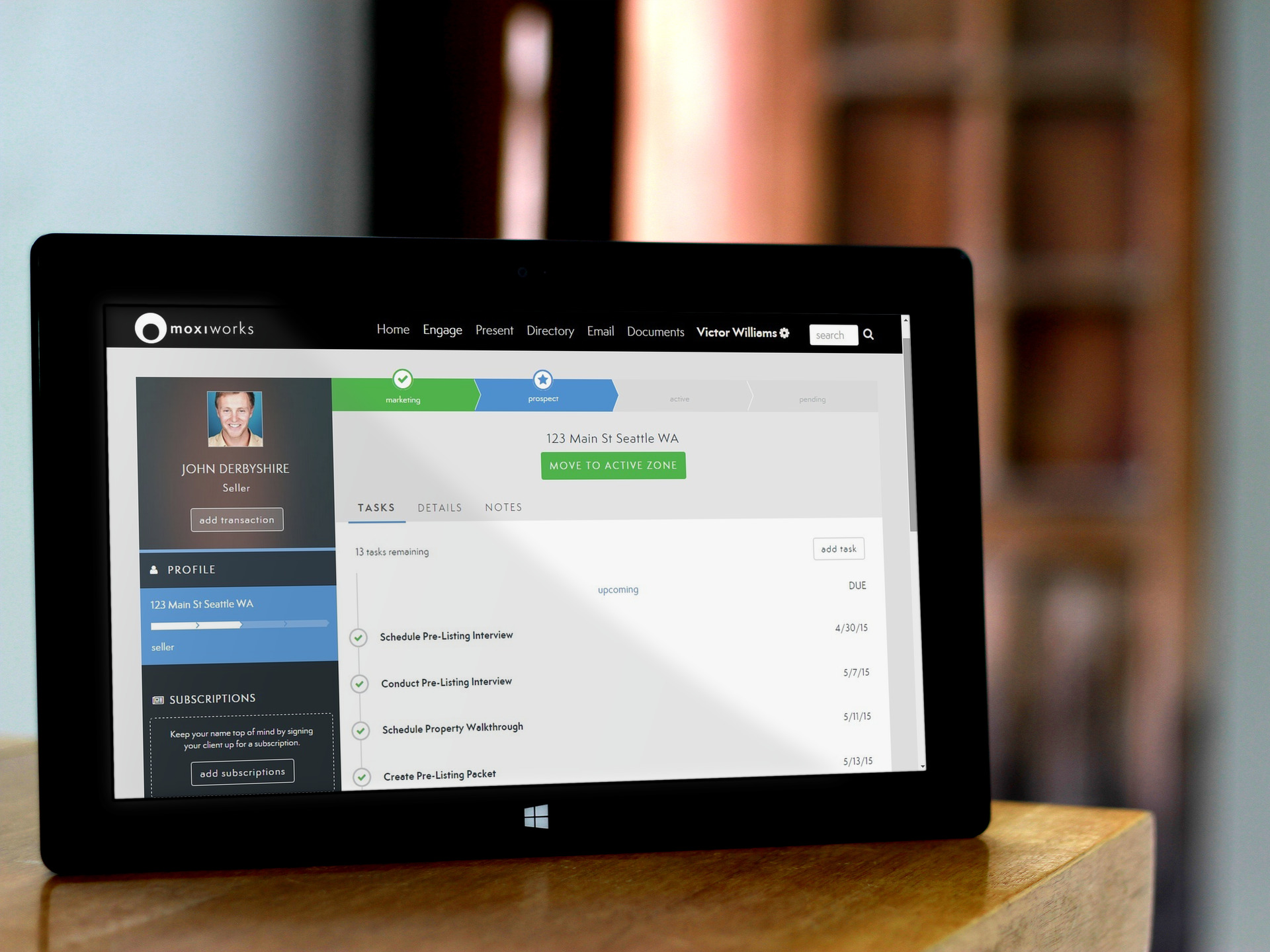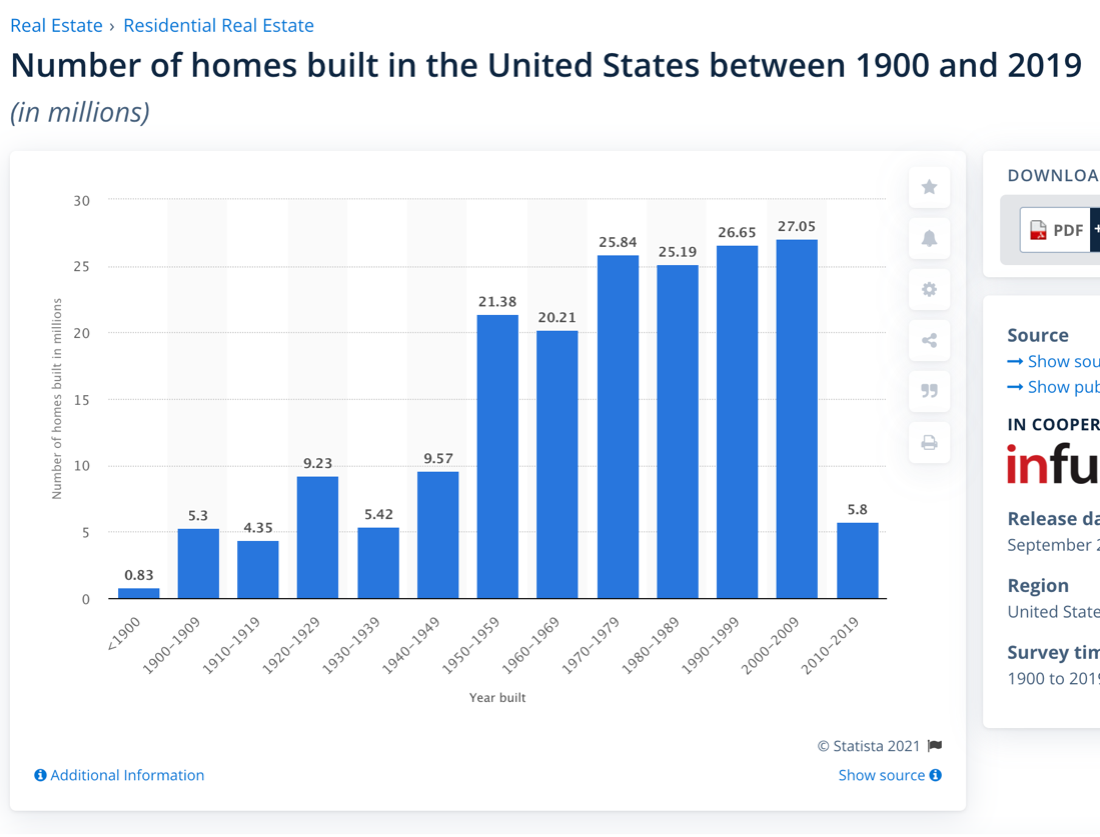Virtuance Partners with MoxiWorks, Bringing Agents an Efficient and Reliable Photo Solution

Through this partnership, MoxiWorks users will have access to Virtuance’s AI-powered HDReal® images, 24/7 online booking services, and their national network of professional photographers
Key Takeaways:
- Virtuance partners with MoxiWorks to bring agents direct access to Virtuance’s photography and virtual tour services
- The new partnership will connect Virtuance’s national network of professional photographers with MoxiWork’s 400,000+ users.
- Full integration will be available soon
SEATTLE, Wa. (May 21, 2021) – MoxiWorks, the leading real estate technology platform, announced today a new partnership with Virtuance, a technology company that provides real estate marketers with professional photography and virtual tours nationwide. Virtuance offers AI-powered HDReal® images among other visual marketing services including virtual tours, 360° panos, and drone photography.

“MoxiWorks and Virtuance are aligned in our goals of using technology to create more effective, simpler solutions for real estate professionals all the way from pre-listing to close. This relationship is a big win for brokerages, agents, and homesellers,” said Jeff Corn, Co-Founder and CEO of Virtuance. “We’re thrilled to partner with MoxiWorks to provide their customers seamless integrations into Virtuance’s suite of visual marketing services.”
Through this partnership, Virtuance will connect MoxiWorks users with professional photographers around the country through scheduling available on their online platform 24/7. Once the shoot is scheduled, Virtuance processes the images through a series of 25 proprietary algorithmic adjustments powered by AI to deliver high quality images the day after the photoshoot.
 “In today’s low-inventory market, agents need to compete more intensely, and we’re excited to arm MoxiWorks clients withVirtuance’s advanced technology”, says Krista Thomsen, MoxiWorks’ Senior Manager, Partnerships & Integrations. “Virtuance offers an effective and reliable service that delivers great results to agents allowing them to enhance their listings and generate more success.”
“In today’s low-inventory market, agents need to compete more intensely, and we’re excited to arm MoxiWorks clients withVirtuance’s advanced technology”, says Krista Thomsen, MoxiWorks’ Senior Manager, Partnerships & Integrations. “Virtuance offers an effective and reliable service that delivers great results to agents allowing them to enhance their listings and generate more success.”
The new partnership will connect Virtuance’s nationwide network of photographers with MoxiWork’s 400,000+ agents.
To learn more about this integration and how it can benefit your business, visit moxiworks.com and virtuance.com.
About Virtuance
Virtuance is a technology company that connects real estate marketers with professional photography and 3D virtual tours nationwide. Founded in 2010, Virtuance empowers real estate brands to efficiently scale by offering consistent images powered by their HDReal® technology, world-class support, and a network of hundreds of photographers, providing a streamlined and delightful experience for selling and renting properties. Learn more at virtuance.com.
About MoxiWorks
MoxiWorks is a comprehensive open platform system for large residential real estate brokerages that serves over 800 brokerages and more than 400,000 agents nationwide that account for more than 20% of the transactions in the U.S. MoxiWorks’ customer retention over the past seven years stands proudly at 96%. Their integrated tools are centered on sphere methodology that increases agents’ repeat and referral business by 54%, while lowering overall technology, training, and support costs for the brokerage. The open platform known as the MoxiCloud has tools from more than 100 partners that integrate to create unique brokerage solutions. Find more information at moxiworks.com.
###
MoxiWorks – Let’s sell more homes together
###
For more information on this topic and other press inquiries at MoxiWorks, please contact Jordan Barrish at Jordan.barrish@moxiworks.com.
Strong Spring of Home Sales Continue, Stronger Summer Ahead

We are up to our eyeballs in the inventory shortage. You can’t look at one news site without seeing something about the shortage. This has been going on for months and months, so what gives?
A few things.
First of all, we still strongly believe this is not an inventory shortage, but a listings shortage. The homes and sellers are out there, they just need their trusted real estate agent and advisor (you) to help them understand the value of their home, and how to navigate this frothy market.
But there is something even more important than the pandemic that is impacting inventory.
According to a Statista study in September of 2020, there was a 79% decrease in new homes built between 2010 and 2019. Between 2010 and 2019 there were only 5.8 million new homes built while the three decades before it 27 million, 26 million and 25 million new homes were built respectively. The last time we saw such a low amount of new construction was the 1930s.
This stark decrease is certainly a factor in what we are seeing today alongside the pandemic.
But, it doesn’t mean there is a reason to panic.
The fundamentals of why people move (marriage, divorce, new babies, empty nest, new job, retirement, etc) have not changed and will not change. If anything, the new flexibility so many working adults across the US are seeing with remote work is likely to increase and let them move for work, but on their own terms.
And to top this all off, Freddie Mac expects home sales to reach 7.1 million in 2021. 7.1 million homes would be a 25% increase year over year in home sales from 2020 which saw 5.65 million home sales, during a pandemic, while we only say 5.25 million in 2019.
If Freddie Mac is correct in their predictions, we should feel hopeful. Those listings have to come through an agent, will it be you?
Now let’s dig into April and the upcoming May & June outlook.
April Home Sales
April closed out with 539K home sales across the country. That’s 5% less than our prediction of 565K. This was a 3% increase from the home sales in March, but year over year it was a 48% increase. Not at all surprising as April 2020 was when COVID-19 was really setting in across the US and only 364K homes were sold.
May and June home sales prediction
Our May prediction has been adjusted slightly from last month and we are now predicting there will be 622K home sales which would be a 15% increase month over month and 72% year over year.
Based on the activity inside our MoxiWorks products we predict there will be 650K home sales in June which would be a 5% increase month over month and a 29% increase YOY.

You control the listings
Our rallying cry remains that you and your agents have the control to make the market. 7.1 million homes won’t sell themselves.
So do the thoughtful home property reviews, do the comps analysis, show your clients why selling their home is a good idea. Doing these presentations are proven to make these transactions happen.
Our data team just pulled the stats on agents using MoxiPresent with their clients and the results speak for themselves:
- In 2020, agents fully utilizing MoxiPresent did 77% more transactions and saw 93% higher sales volume than those without MoxiPresent.
There is a lot to shake out in the market, so let’s stay proactive and persistent, and let’s make the market.
The Home Sales Predictor is a brand-new set of prediction data that dives into the number of presentations created and the correlated number of U.S. home sales. This data is provided by MoxiWorks with insights from their MoxiPresent product.
Get our Home Sales Predictor Monthly Report delivered to your inbox!
Find a Partner – Not Just a Tech Vendor

It happens too often … brokers come to us frustrated and exhausted, stuck in a contract with a tech vendor that promised them the world but fell short. Even if their technology is cutting it, they aren’t getting the service they need or deserve. Technology companies often see themselves as vendors rather than true partners to their clients.
That’s not the case at MoxiWorks.
Customer service is deeply rooted in how we operate. People expect good customer service, remember excellent customer service, and never forget terrible customer service. We understand that it is fundamental to ensuring that our clients are long-term, successful customers of ours. That is why at MoxiWorks, your success is our success.
Success with MoxiWorks
The two largest groups that ensure our clients are successful are our Account Management and Customer Success teams. The Account Management team is our client’s main point of contact and trusted business advisors, providing valuable guidance and support for our suite of tools and partner services. They gain an understanding of our client’s organization, their business drivers, and their service needs, providing a delivery plan that ensures their success with MoxiWorks’ suite of services. The Customer Success team is responsible for ensuring that our clients are wildly successful while using MoxiWorks. They offer several different channels for clients to get assistance including chat, scheduled call, email and help center.
Said best by our Manager of Customer Success and well-seasoned MoxiWorks employee, Nathan Losch, “Our team can help MoxiWorks users maximize the effectiveness of our products, increase adoption of the technology, and reduce the number of users who abandon the technology.”
Our Philosophy Behind Customer Service
Nathan explains that “MoxiWorks wants every interaction with our team to have the result of the requester being in a better situation than before contacting us. Maybe that means coaching on how to use the product. Maybe it means handling something for somebody. Maybe that means getting a bug reported and scheduled or referring the requester to the appropriate party who can help them if we cannot. We want to make it as easy as possible for the agent to successfully use our system to sell more homes.”
I am sure you have heard the quote by Maya Angelou “at the end of the day people won’t remember what you said or did, they will remember how you made them feel.” We believe that to be true, especially in customer service. We want to make sure that MoxiWorks users always feel supported and never feel overwhelmed or frustrated.
The Proof is in the Data
Our Customer Success team has worked hard to maintain an astounding customer support satisfaction rating of 90% or higher over the last year and continue to do so as reported in a satisfaction poll sent to every single agent that uses our support. This means that at least 9 times out of 10, agents are leaving their experience with Customer Success feeling great about what they learned and accomplished. As a brokerage, that means your agents are continually seeing the value of your technology investment, and in turn, your investment in their success. When you compare this to the industry average customer support satisfaction rating of 78%, it is clear that with MoxiWorks, your agents won’t ever want to try to go elsewhere.
And it’s not just agents. Brokerages who choose MoxiWorks stay with MoxiWorks. Our customer retention rate stands proudly at 97%. Yes, 97% of our customers who have joined forces with MoxiWorks have stayed with us. Our clients see us as a true partner and we see our clients as customers for life, evolving with them and addressing the ever-changing needs of the industry. Rolling out new technology is never a desirable task for a brokerage or any business for that matter. With MoxiWorks, you can find ease knowing that you have found a technology partner for life.
On top of all of this, MoxiWorks is really proud of our Net Promoter Score (NPS). NPS is the world’s leading metric for measuring customer satisfaction and loyalty. It is designed to gauge how willing a customer is to recommend a product or service to others. We actively measure our NPS of key stakeholders and have an NPS of 54, significantly higher than the industry average of 26. This is measured by asking customers the question “on a sale of 0 to 10, how likely is it that you would recommend our organization to a friend or colleague?” If they answer 0-6, they are detractors, if they answer 7-8, they are passives, and if they answer 9-10, they are promoters. Then, take the percentage of responders that were detractors and subtract it from the percentage of responders that were promoters, and you will have you NPS score. MoxiWorks customers are not just satisfied with their service, but the vast majority of them would recommend MoxiWorks to a friend or colleague as well.
The Process
So how does it all come together for our clients? First comes our ‘Engagement Cookbook’ and onboarding. According to Bill Yaman, our VP of Customer Engagement, this process “has been refined over the years as a result of hundreds of onboarding engagements. It is a multi-phase process with one overriding principle– we are successful together only if the Moxi team really understands your business requirements and becomes an extension of your brand, training methodology, and marketing team. Moxi onboarding is not a ‘one size fits all’ model. Rather, it will vary based on business need, product requirements, geography, etc.”
Also, during this time, our Training and Creative Services teams are working alongside Account Management to ensure all-around success with onboarding, launch, and ongoing adoption. Training will develop curriculums based on a client’s needs and market while Creative Services will work as an extension of our clients’ marketing teams ensuring their content is beautiful and impactful.
Next, once MoxiWorks services are launched, the Account Management team will continue their involvement to ensure that agent adoption and success continues. Shared by Bill Yaman, “we have brokerages that have been clients for five years and we are still holding weekly or bi-weekly meetings with them. That is fundamentally how we achieve 97% customer retention – which is unrivaled in the industry. If you exclude customers that signed on with us in the past year, our average customer has been with us between four and five years.”
Once clients are onboarded, they are also able to utilize our Customer Success team. As mentioned before, assistance can be found via chat, scheduled call, email or help center. Nathan added, “our representatives do not have a numerical or time-based quota; they will help you for as long as it takes.”
At MoxiWorks, customer is key. If our customers are successful, we are successful. When a brokerage chooses us, they aren’t just getting a robust platform of tools to level up their real estate business, they are also getting a team of rock stars to assist and guide them along the way.
650K homes sales on the horizon in May

We know what you are thinking. We are thinking it, too. 650K home sales in May?
But this is what our predictor says. Based on the activity inside our products, we predict there will be 650,000 home sales in May.
We know that feels high when inventory is low, but as York Baur and Matthew Ferrara discussed last month inventory isn’t the problem, it’s listings. And from the activity we are seeing in our products it seems like listings are on the climb.
March Recap
In March we ended up with 506K home sales (we predicted 483k so we were within 5% accuracy) which was a 30% increase from the number of home sales in February 2021 and was a 21% increase year-over-year from March 2020. It feels good to see that seasonal increase begin after the strange months we had in January and February. And looking ahead to April and May it looks like we are really back on the upswing.
April & May Predictions
For April we predict there will 565k home sales which will be an 11% increase in home sales from March 2021 and a 57% increase year-over-year from April 2020. In May our prediction of 650k home sales will be a 15% increase from April and an 82% increase YOY from May 2020. Both a 57% and 82% increase may sound extreme, but it’s unfortunately due to what a scary and uncertain time it was this time last year so it makes complete sense we would see that dramatic of an increase YOY.

Source: MoxiWorks Apr-May-21 Home Sales Predictor
But the good news is everything is continuing to trend up in every way when it comes to real estate activity.
As the light at the end of the pandemic tunnel continues to shine brighter more and more homes will be bought and sold as people are starting to re-evaluate how they spend their time, how they work and especially where they live. It’s also clear that the economy “feels” stronger which could be a good sign for home sales and what we are expecting we will see in May.
Let’s continue to all make the market.
The Home Sales Predictor is a brand-new set of prediction data that dives into the number of presentations created and the correlated number of U.S. home sales. This data is provided by MoxiWorks with insights from their MoxiPresent product.
Get our Home Sales Predictor Monthly Report delivered to your inbox!
Pocket Listings: What You Need to Know

By Jessie Trapp, Marketing Coordinator
 It’s a cut-throat market out there. Inventory seems to become increasingly scarce by the day, and sellers continue to hold tight to their reign as the power players of the real estate world. With agents scrambling to find a competitive edge, it’s no surprise that some of the tactics being used are stirring up serious controversy within the industry.
It’s a cut-throat market out there. Inventory seems to become increasingly scarce by the day, and sellers continue to hold tight to their reign as the power players of the real estate world. With agents scrambling to find a competitive edge, it’s no surprise that some of the tactics being used are stirring up serious controversy within the industry.
Enter: pocket listings. The actual usage of the term “pocket listing” can be somewhat confusing, as it is often used to describe multiple types of property listings that agents have different intentions for. Put simply, a pocket listing is a signed property that an agent has acquired but hasn’t listed on the MLS (Multiple Listing Service). In some cases, the agent intends to list it but simply hasn’t yet, however, for the most part it means that they have a property and intend to sell it to someone in their sphere without ever even placing it on the MLS at all. If you haven’t already, now is the perfect time to put this method on your radar because the secrets out – and clients are asking about it.
The topic of pocket listings is a fiery one among agents because it tends to walk on a fine line between tactical and, arguably, unethical. Agents are, in compliance with the Code of Ethics, required to do everything in their power to ensure that they get the best offer for their client. Those against the practice claim that withholding a pocket listing from the MLS presents the risk of missing out on higher offers that could result from making it accessible to the general public, therefore failing to act in the best interest of the client. Transactions for pocket listings also generally remain in the hands of the listing agent, as they often represent the both the seller and the buyer. Some opposed to the practice also express concern that some agents are too biased in favor of it due to the potentially higher commission in it for them, and fear that clients might not always be well educated on the ramifications associated with the practice.
Although these risks likely account for why pocket listings are usually not considered to be the standard practice in real estate, sellers occasionally prefer it and it has the potential to give agents a notable advantage. Not only can the limited exposure component of the method offer a more private experience for the seller, but it can also simplify the offer process all together and speed up the transaction time. For sellers who are wanting a quick sell, this aspect can be a major incentive to sell their home as a pocket listing. By avoiding listing a property on the MLS you lower the amount of wide spread interest and walk-throughs but, in the right situation, you can also increase the quality and seriousness of the interest received. This brings it back to the agent- because pocket listings take the MLS exposure out of the equation, the quality and health of your CRM and overall sphere plays a major role in how successful you can actually be with this strategy. Not sure if your sphere is up to par? Take a look at this piece we wrote to help you gauge where you stand.
Buyers also occasionally prefer to make offers on pocket properties because less competition means that they are more likely to avoid the grueling bidding war process. Again, depending on the situation this can be negative for both buyers and sellers, but some continue to prefer its more simplistic approach and pursue it anyway. For the sake of transparency, some in the industry feel as though agents should always present pocket listings as an option on the table for their clients. This could be risky for both the client and the agent if handled improperly. As the agent, it’s your responsibility to make sure you’re practicing within the laws, which vary among states, and making the pros and cons associated with the method abundantly clear so that sellers can make informed decisions and you can cover yourself against any potential violations.
Like I said, this topic is complex, and people are all over the board in relation to how they feel about it. The practice is very unregulated, meaning there aren’t reliable statistics reflecting how many agents are actually engaging in it. It does, however, seem safe to say that it’s usage is significant considering tech companies, like this one, are viewing it as an opportunity to create a structured platform for it. Regardless of whether you believe this approach to be an epidemic or a tool, it’s important to analyze its effect on the market from all angles because let’s face it- you’re bound to run into it eventually, and you’re going to want backup.
What to look for in a CRM

By Maddie Jostol
First of all… yes, you need a CRM. If you haven’t onboarded a standard agent CRM for your brokerage, then 2018 is the year to do so. A CRM (customer relationship management system) is where all of your agents keep and nurture their contacts, market to their sphere, manage their sales flow, track their goals, and much more. The CRM glues everything together.
What impact could a CRM have on your business? Here are a few quick facts:
- ” 74% of businesses using a CRM report improved customer relationships (Annuitas Group).
- ” Conversion rates can improve by 300% with a CRM in place (Cloudswave).
- ” Lead cost is reduced by 23% with a CRM in place (Cloudswave).
Vetting technologies can be challenging and complicated, especially a system as robust as a CRM. So, what should you be looking for in a CRM for your agents? Below are our recommendations for what you should consider when it comes to a CRM for your brokerage.
Your CRM should ‘understand’ the real estate business.
In general, CRMs should be intuitive. The system’s sales flow, prompts, and coaching should align with your business process. The home sales process is a unique one compared to other businesses. When considering an agent CRM, make sure the system makes sense for this sales process, taking into consideration sphere marketing, a long sales cycle, GCI goals, the transaction process, etc.
It must support your sphere-selling efforts.
The sphere-selling methodology is the way of the future. When agents strategically leverage their spheres of influence, their businesses grow in a sustainable way. In a competitive landscape, where all markets are thirsty for leads, an agent’s sphere is their power.
If you’ve invested in training and coaching to encourage your agents to leverage sphere-selling, they should be using a CRM that supports those efforts. What’s this look like? It means having your CRM integrated with your other contact databases, relevant segmentation options, and aggregated public data to keep up with the people in your sphere.
Integration will power your business.
Integration powers your business. In a sea of ad hoc tools, we’re all left attempting to remember passwords and experiencing tool fatigue. Select technology solutions for your brokerage that integrate with each other. This means that an agent can use all of their tools with a single sign-on and a cohesive flow.
Take lead generation, for example. When leads are generated – whether they’re from the agent’s website, or purchased from a lead provider, they should immediately appear in the agent’s CRM, and the agent should be prompted to follow up. This is bare minimum for a CRM. When it comes to sales enablement, guiding an agent through the necessary tasks from lead generation all the way through closing is key.
Integration goes far beyond lead generation. With Moxi Engage CRM, for example, an agents’ leads flow straight into their CRM, but they can also purchase client gifts, advertise on Facebook, execute print marketing campaigns, manage transactions, and much more, directly from their Engage account.
It must have live MLS data.
When it comes to a CRM in real estate, MLS integration is a must-have. When agents win listings, those listings automatically with their CRM, enabling them to truly manage the transaction from start to finish. It means agents never have to manually enter property data, saving time, and negating errors.
It should improve agent productivity.
When we talk about CRMs, we often talk about “tasks” and “actions” which, for some, can feel like the system is adding work. That’s just not true. The tasks that your CRM prompts should be actions that agents are already taking (and if they aren’t, then it’s even more reason to get a system in place). What the CRM does is streamline these tasks and remind the agent, so they don’t miss a beat.
Logging into your CRM and seeing everything you need to accomplish that day will change an agent’s workflow for the better. They always know what they need to do in order to reach their goals. They’ll be able to see who in their sphere they should reach out to, and be reminded to follow up with that one lead they talked to last week. They’ll be able to look back and see when they last spoke with so-and-so, and be reminded to send Mr. and Mrs. Smith a gift for their house-versary.
This increase in productivity all comes back to your business. Agents are not only able to accomplish more, closing more deals, but they also find better work/life balance, improving retention at your brokerage. Improved productivity adds up to revenue, having a nice effect on your business’ bottom line.
It’s a component of your open platform.
Your agent CRM is a (vital) piece of a larger puzzle. Your brokerage platform is the ecosystem where all of your technology tools and services live, integrate, and share data. Powering that is the CRM, hosting agent databases, consumer data, property data, and driving business results.
To learn more about the Moxi Engage CRM and the Moxi Cloud open platform, reach out to us to talk to a member of our team.
Leverage Content Marketing to Grow Your Business

 By Tiana Baur
By Tiana Baur
Time to take the “pitch” out of your marketing strategy. Content is the here and now, and the future of marketing as we know it. Growing your business is all about leads, and attracting said leads comes much easier when leveraging content marketing.
Chances are you’ve heard of content marketing, but maybe you aren’t exactly sure what it entails. According to the Content Marketing Institute, a resource for – you guessed it – all things content marketing, describes it like this:
“Content marketing is a strategic marketing approach focused on creating and distributing valuable, relevant, and consistent content to attract and retain a clearly defined audience – and, ultimately, to drive profitable customer action.”
The general concept behind it, is getting rid of the “pitch” aspect many marketers in the past have come to love. With this style, instead of pitching your real estate services as an agent, you are providing truly relevant and useful content for your prospects and current clients, helping them problem solve and get their wanted information. In doing so, they will keep coming back for the valuable content you’re providing them on your agent website or blog, making their decision to choose you for their next transaction an easy one.
Unfortunately, content marketing takes some work. It takes quality planning and regular distribution of content that builds your brand and your awareness in the market. There are three things you must do in order to have the content marketing foundation that will pay dividends:
1. Start with a content calendar
A content calendar is the engine that keeps your car running. It also keeps you focused, with your eyes on the road, knowing which turns to take and which roads to drive on. A little content here and there isn’t going to give you the leads and return you are looking for. Consistency is key. Building a proper content calendar that fits your schedule and style is essential. If you’re looking for a template, we suggest taking some notes from this one.
2. Create unique, highly shareable content
A content calendar means nothing if the content you’re putting out is total crap, so play to your strengths and your specializations. You can’t know everything about every topic; pick three or four main umbrella topics and build out your content from there. Maybe it’s DIY projects, fixer-uppers, or interior design. Maybe it’s deep market analytics and investment properties. You know you best and you want to be able to talk intelligently about the topics when you meet these potential clients in person.
3. Provide value
This can mean different things depending on your unique audience. Think about who you want to target. Is it the neighborhood you do the most business in? Or first-time home buyers? Whatever your ideal client looks like, focus on them.
At the end of the day, you get out of marketing what you put into it. Content marketing can take more planning, creating, and time in general. However, it is a prime example of quality over quantity and your audience will thank you for it. This is what gives prospects that little extra motivation to do the one thing you want them to: pick up the phone and dial your number.
If you want more info on content marketing, see Content Marketing Institute’s getting started guide.
Moxi Works secures outside investment

CLICK HERE TO READ THE FULL ARTICLE The real estate technology startup Moxi Works has secured an unspecified investment stake from Hanna Holdings of Pittsburgh. Moxi Works has created an open-platform system, called Moxi Cloud, for large residential real estate brokerages, which serves over 100,000 agents and 50 brokerages nationwide.
The Ultimate Guide to Email Security

 By Andrew E.
By Andrew E.
How to protect your email account from getting hacked or phished
Equifax. Target. Uber. LinkedIn. Yahoo. If there is one thing we have all learned, it is that nothing is safe these days, these companies – and others – clearly cannot be counted on to safeguard you from the dangers of hackers. In 2016 alone over 4 billion data records were stolen across the world.
Your email account should be treated as one the most closely guarded personal effects in your life. What were to happen if your email account were compromised and all the escrow money or their social security numbers your client had entrusted to you vanished due to you clicking on a suspect email link? That is a scenario none of us want.
To help safeguard you, and the interests of those you represent, use these five stages of email password security to protect your email account.
Level #1: “Uh, duh.”
The first stage is all about covering the basic best practices of email security.
Don’t use password, abcedfg or 1234567 as your email password
The best thing you can do today is to not use the things like “password,” abcdefg or 1234567 as your email passwords. According to Betterbuys.com these types of passwords can take a hacker just 0.29 milliseconds to hack and compromise your account.
0.29 Milliseconds: The amount of time it takes a hacker to crack a generic password.
Don’t believe me? Betterbuys.com has this nifty tool you can use to test the strength of your password (don’t worry they don’t keep the passwords.)

“Estimating Password-Cracking Times” by BetterBuys
Use at least 12 characters when creating a password
The longer your password, the longer it takes hackers to crack your accounts and access sensitive information. On average, passwords with at least 12 characters can potentially take two centuries to crack.
Use Lowercase, Uppercase, numeric and special characters
Just how you construct, your password is just as important as a character count. The more thought you put into how your passwords are constructed, the more time it can take hackers to crack your account.
Level #2: “So you’re telling me there’s a chance.” – Lloyd Christmas
Even with a strong password, your chances of being compromised are still high. Hackers and phishers use a variety of programs and tactics to bilk people out of the personal information and other valuables (Mr. Robot anyone?)
At stage two it is about adding extra protection.
Use two-factor verification
The short version: When you use two-factor verification should someone have your password, they should not be able to login to your account(s) without first entering a security code sent via SMS text or through the use of an authentication app. The thinking behind this is “prove whom you say you are” especially if you are attempting to log in from a new phone or laptop.
Increase your phishing detection skills
Phishing occurs when a nefarious entity falsely represents themselves under the guise of being a legitimate company. Their end goal: tricking you into providing sensitive personal information, erroneously sending them money, and the list goes on.
To help you get better at recognizing fake websites and not giving up the proverbial farm, LifeHacker has some great tips, tricks, and tools you can use to protect you from phishing attempts.
Go here for more information on email verification and validation!
Level #3: “That’s interesting, man.” – The Dude
Proactively monitoring your email account can be a great tool for keeping yourself safe and it is easy to set up. At this stage, it is all about keeping yourself informed about what is going on with your account(s) and making sure nothing funny is going on.
Turn on recent event monitoring
If you use notification messages for any apps on your smartphone or tablet, recent event notifications work in a similar way. This type of security helps you to know the exact time, place, and device that was used each time to access your account. Each email provider has different ways of customizing this type of security, so check with your email provider which options are available. I use both email and text notifications for my Gmail account to make sure I am not potentially missing out on any suspicious activity.
Level #4: “I’m putting it in the vault.” – Jerry Seinfeld
With the new layers of security for your email account (and, hopefully, your other important accounts) it can feel overwhelming trying to manage all the new changes. Fortunately, there’s an app for that.
Invest in a password manager vault app
It may seem counterproductive to stage one, but, utilizing a highly encrypted third-party solution for managing all of your passwords can be a lifesaver both for your sanity and time. The concept is simple: enter your login credentials for an account and utilize this as your single source of truth for managing all your accounts including your email account.
There are a lot of great options out on the market. To help you pick the one that is the best fit for you, LifeHacker has put together a great article highlighting the top five options ranked by consumers (I use LastPass).
Level #5: “You will lose.” – Ivan Drago
This stage is not for the lighthearted. If you want to have the highest level of protection against hacking, then read on.
Invest in a YubiKey
A Yubikey is the ultimate last line of defense in email security. Yubikey is a small thumb drive about the size of a quarter, fits on your keychain, and acts as a physical password vault. Translation: if you do not stick the Yubikey into your device, you can not access your email account.
You might be skeptical, but I can personally attest that this is one of my top three best personal investments of 2017. After experiencing my email account being hacked this year, I swore never to let it happen again, thus stumbling upon Yubikey. You can also have multiple Yubikeys tied to your accounts, so, just like your keys, if it happens to get misplaced, you can use a spare until finding your primary one. There is a variety of Yubikey options, so choose the one that best fits your needs.
How [Not] to Write a Real Estate Agent Bio

 By Maddie Jostol
By Maddie Jostol
It’s something you likely only update if you’re thinking about changing brokerages or you get a new website. If you’ve been in the game a while, but haven’t updated your bio – now is the time.
Your bio is your opportunity to tell someone who you are and what you’re about before you meet. It’s a first impression, in a way. The start of a new year is the perfect time to review your online presence and get those websites and LinkedIn profiles updated, so we’ve compiled a list of tips to help guide you to a winning agent bio.
Don’t sound like a robot – Make it human. Use language that reads similarly to how you would speak while remaining professional. Someone is reading your bio to get to know you, not to see a standard agent boilerplate. Start building a human connection when they read your bio.
Don’t write a novel – Keep it short and sweet. Provide the reader with just enough information to make them decide they want to work with you, without telling your entire life story. 200-350 words is plenty.
Don’t look like everybody else – Focus on unique expertise. Do you know a lot about housing for veterans? Do you speak a second language? Are you well-connected in a particular community? Play up your strengths and set yourself apart.
Don’t start from the beginning – Start with what makes you the best now, and then support that with your past experience.
Don’t be a stranger – Real estate is all about community. People take pride in where they live, so use that to your advantage. Talk about your local area as if you love it there and people will respond positively.
Don’t start with how many years you’ve been in the biz – “I’ve been in real estate for 25 years” doesn’t make me want to keep reading. Experience absolutely matters, but because of what you’ve accomplished and the service you provide your clients, not in the number of years. Not to mention, starting your bio this way will sound generic and unimaginative.
Don’t limit yourself to text – Try a video bio. Video gives you the opportunity to show your personality and resonate with viewers as a true consultant.
Don’t use gibberish – We’ve all seen those bios with so many designations following the author’s name that you can’t decipher it all. By all means, note your qualifications and don’t shy away from sharing your designations, just don’t make it look like your cat sat on the keyboard while you were typing. Include your professional experience in a thoughtful, selective way.
Don’t advertise – There’s a time and a place for advertising. Maybe they clicked on an ad to get to your website where they’re reading your bio. However, your bio is an opportunity for someone to get to know you. Sure, the end goal is to win a listing, but that’ll happen because they want to work with YOU.


 Facebook
Facebook
 X
X
 Pinterest
Pinterest
 Copy Link
Copy Link
